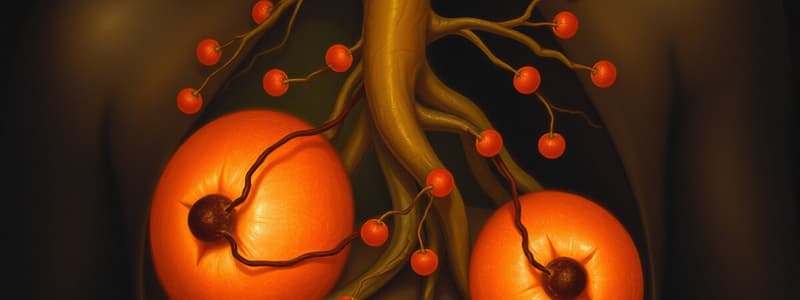Podcast
Questions and Answers
What primary role does the lymphatic system serve in the body?
What primary role does the lymphatic system serve in the body?
- It collects interstitial fluid and returns it to the circulatory system. (correct)
- It absorbs oxygen directly from the environment.
- It facilitates the exchange of nutrients between blood and tissues.
- It transports hormones throughout the body.
Which statement accurately describes the function of lacteals?
Which statement accurately describes the function of lacteals?
- They absorb excess fluids from the interstitial space.
- They transport red blood cells to the lymph nodes.
- They facilitate the absorption of dietary fats into the lymphatic system. (correct)
- They produce immune cells that fight pathogens.
How does lymph differ from blood in terms of composition?
How does lymph differ from blood in terms of composition?
- Lymph is produced in the liver while blood originates from bone marrow.
- Lymph contains a higher concentration of nutrients than blood.
- Lymph contains fewer leukocytes than blood.
- Lymph contains white blood cells essential for immune defense. (correct)
Where in the body are lacteals specifically located?
Where in the body are lacteals specifically located?
What is the ultimate destination of the absorbed fats that enter the lymphatic system via lacteals?
What is the ultimate destination of the absorbed fats that enter the lymphatic system via lacteals?
What role does blood pressure play at the arterial end of capillaries?
What role does blood pressure play at the arterial end of capillaries?
What initiates the reabsorption of interstitial fluid at the venous end of capillaries?
What initiates the reabsorption of interstitial fluid at the venous end of capillaries?
Which statement accurately describes lymph after it is absorbed by lymphatic capillaries?
Which statement accurately describes lymph after it is absorbed by lymphatic capillaries?
What is the ultimate fate of lymph in the body?
What is the ultimate fate of lymph in the body?
What primary function do lymph nodes serve in relation to lymph?
What primary function do lymph nodes serve in relation to lymph?
What key characteristic distinguishes angiosperms from gymnosperms?
What key characteristic distinguishes angiosperms from gymnosperms?
Which of the following is NOT a type of seed-producing plant?
Which of the following is NOT a type of seed-producing plant?
What type of seeds do gymnosperms produce?
What type of seeds do gymnosperms produce?
Which of the following statements about tracheophytes is true?
Which of the following statements about tracheophytes is true?
What role do fruits serve in angiosperms?
What role do fruits serve in angiosperms?
Which feature is unique to bryophytes compared to tracheophytes?
Which feature is unique to bryophytes compared to tracheophytes?
What characteristic do both gymnosperms and angiosperms share?
What characteristic do both gymnosperms and angiosperms share?
Which statement correctly describes the growth patterns of tracheophytes?
Which statement correctly describes the growth patterns of tracheophytes?
What is a defining trait of bryophytes compared to tracheophytes?
What is a defining trait of bryophytes compared to tracheophytes?
Which of the following groups includes both seed-bearing and seedless plants?
Which of the following groups includes both seed-bearing and seedless plants?
Flashcards are hidden until you start studying
Study Notes
Lymphatic System
- Collects interstitial fluid that leaks from blood vessels and returns it as lymph to the circulatory system.
- Lymph contains white blood cells crucial for the immune system, aiding in defense against pathogens.
Lacteals
- Specialized lymphatic vessels found in the villi of the small intestine.
- Function to absorb dietary fats from the digestive tract into the lymphatic system.
- Eventually, absorbed fats in lymph are transported into the bloodstream for distribution.
Lymphatic System Overview
- The Lymphatic System plays a crucial role in maintaining interstitial fluid levels in the body.
- Composed of lymphatic capillaries, lymphatic vessels, and lymph nodes.
Fluid Dynamics in Capillaries
- Blood pressure facilitates net filtration of fluid from the arterial end of capillaries into the interstitial space.
- Higher concentrations of proteins in the blood create osmotic pressure, leading to net reabsorption of fluid at the venous end of capillaries.
Lymph Formation and Function
- Excess interstitial fluid, once collected by lymphatic capillaries, is termed lymph (or lymphatic fluid).
- Lymphatic capillaries ensure the removal of surplus fluid, preventing edema.
Return to Circulatory System
- Lymph is transported toward the heart through a network of lymphatic vessels.
- After its journey, lymph re-enters the circulatory system, contributing to overall fluid balance and distribution within the body.
Types of Seed-Producing Plants
- Two categories of seed-producing plants exist: angiosperms and gymnosperms.
- Both types are classified as tracheophytes, indicating they possess vascular tissues (xylem and phloem) for water and nutrient transport.
Angiosperms
- Angiosperms are known as flowering plants.
- They produce fruit, which serves to contain and protect their seeds.
- Considered the most diverse group within seed-producing plants.
Gymnosperms
- Gymnosperms are characterized as cone-bearing plants.
- They produce unprotected seeds, meaning seeds are not enclosed in fruit.
- Often found in regions with varying climates, adapted to survive in harsher environments.
Bryophytes
- Includes liverworts and mosses, primarily consisting of small, nonvascular plants.
- Lacks xylem and phloem, resulting in limited growth and nutrient transportation.
- Reproduces via spores and exhibits a seedless reproductive strategy, devoid of flowers or fruits.
- Characteristically low-growing, often spreading horizontally across surfaces.
- Utilizes rhizoids for anchorage and stability, instead of true roots.
Tracheophytes
- Comprised of seed-bearing groups such as gymnosperms and angiosperms, as well as seedless varieties like ferns.
- Possesses vascular tissues, including xylem for water transport and phloem for nutrient distribution, allowing for larger growth.
- Capable of reproducing through seeds (producing flowers and fruits) or spores, showcasing a diverse reproductive strategy.
- Exhibits both vertical and horizontal growth patterns, enhancing adaptability to various environments.
- Features a well-developed root system, providing stability and access to water and nutrients.
Studying That Suits You
Use AI to generate personalized quizzes and flashcards to suit your learning preferences.




